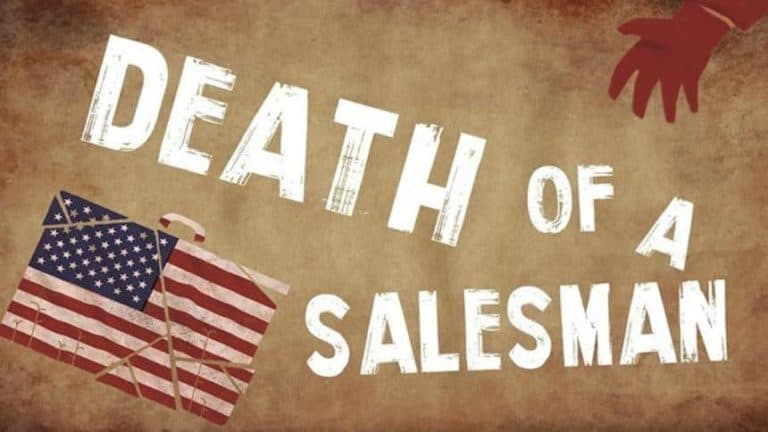If the external plot of Death of a Salesman may be divided into chronologically organised sequences: Act One (Monday evening and night); Act Two (Tuesday), and the Requiem a few days after (Willy’s burial), the same is not true of the internal plot: Willy’s stream of consciousness.
In “the inside of Willy’s head”, past and present are blurred. Memories constantly impinge on present situations and, conversely, the present is put at some distance by the flood of recollections.
The past/present dichotomy is replaced by a non-past; non-present, in which different temporal layers commingle and coalesce. This non-past/non-present is confined to Willy’s inner mind, to Willy’s subjective world.
‘A mobile concurrency of past and present’
(The expression is by Miller, from his introduction to his Collected Plays, p.26)
Miller’s aim in Death of a Salesman is to erase any gap between a remembered past – that would be evoked through words – and a present that would be performed on stage. In Death of a Salesman both past and present are given theatrical representation.
There is no clear-cut boundary between them. Thanks to the expressionistic technique of scrim and curtain, the characters may exist in both the present and the past. For example, Biff and Happy are seen as teenagers and adults successively.
There are no flashbacks in Death of a Salesman. Better than the erroneous term flashback, the phrase double exposure would be more appropriate. In Willy’s mind, past and present exist on the same level, Willy perceives himself both in the present and in the past – which is made up of various strata.
In a way, Willy is schizophrenic; overwork, worry and repressed guilt have caused his mental collapse. In this state of nervous breakdown, past and present are inextricably mingled, time is, as it were, exploded.
In Death of a Salesman, Willy is both the self-remembering I, looking back upon himself, and the remembered I itself, that is to say the salesman as he used to be. Similarly, the same actors play their present and past selves, this is the case not only for Willy’s sons but also for Bernard, who has become a successful lawyer.
The dramatic unities, notably time, have been abolished in the most radical sense, indeed the function of memory entails a multiplicity of temporal levels, a series of different locations (Boston; New York but also the Prairie – through Willy’s father), and finally a loss of any fixed identity.
In a sense, the exploded house, with its transparent walls, its scrims and curtains is an objective correlative (a concrete, practical, tangible image) for an exploding consciousness, in which spatial and temporal fragments get intertwined.
A survey of the episodes of the past
The past is deeply subjective. It is not uniform. It takes many different shapes.
Recollections
First, some scenes are fully immersed within the past (the boys simonizing the Chevy; the episode of the punching ball; the cellar full of boys; and the contrast between Bernard the anaemic and Biff the Adonis).
Here is a survey of the main episodes that are plunged into the past (music; different lighting):
[21-29]: the united family and their neighbours
[30-31] The same family scene is taken up and prolonged – Bernard is used as a choric voice: “If he doesn’t buckle down he’ll flunk maths” (31)
[36-41] Ben’s first visit: some horseplay between Ben, Biff and Happy (38) “Never fight fair with a stranger, boy” (38)
[66-70] Ben’s second visit. He’s got a proposition for Willy. Willy turns it down. This second visit happens to be on the day of the Ebbets Field Tournament.
[91-95] The climactic episode of the past: Biff finds out about his father in a Boston hotel with his mistress – Miss Francis – a traumatic episode.
All these episodes are framed within the past.
Double exposure
The action unfolds simultaneously in the past and in the present, through Willy’s split consciousness. The effect is achieved through a montage dialogue.
[34-36] The card game scene in stichomythic dialogue. It prepares the shift into the past. As soon as Charley leaves, we enter the past: “through the wall line of the kitchen”.
Stychomythia is a form of repartee in drama: the words of the locutor and those of his interlocutor echo each other. One character takes up the words of his opponent, thus creating antithesis or parallel syntactic constructions :
WILLY: Naa he had seven sons; There’s just one opportunity I had with that man…
BEN: I must make a train, William. There are several properties I’m looking at in Alaska.
WILLY: Sure, sure! If I’d gone with him to Alaska that time, everything would’ve been totally different.
CHARLEY: Go on, you’d froze to death up there.
WILLY: What’re you talking about?
BEN: Opportunity is tremendous in Alaska…
WILLY: Sure, tremendous.
p.35
[89-91] the restaurant scene, and simultaneously, allusions to the day when the Regents results were disclosed – Bernard’s choric voice may be heard and little by little echoes from the Boston hotel become more and more perceptible.
[106-108] Willy is conversing with Ben and, at the same time, answering Linda’s repeated invitations to come to bed.
Hallucinations
Spectators do not lose sight of the present context but are made to understand that suddenly Willy has lapsed into a mental vision and therefore cut himself off from his immediate environment.
(64] In Howard Wagner’s office, Willy stares at the empty seat and addresses Frank, who is of course absent, long dead and gone…
[99] in his garden, as Willy discusses with Ben’s ghost, spectators realise that the ghost is very much a figment of Willy’s distorted mind. In fact, it is Willy talking to himself.
Mnemonic mise-en-abime
From mnemonic (memory), hence a memory within a memory.
[29-31] The scene is set in the past, it stages Willy and Linda, when they were younger, and from this first recollection emerges another recollection (a memory within a memory). In this second recollection, the Woman (Miss Francis) appears, first her voice can be heard. Her laughter permits the shift from one level of the past to another. It seems that the mistress is laughing at the wife’s generous remark:
LINDA: To me you are [slight pause] The handsomest. (First temporal level)
[From the darkness is heard the laughter of a woman…] (Second temporal level)
The stocking is the metonymic object that brings together the two women in Willy’s life: Linda is darning her stockings while Miss Francis is offered brand-new ones by Willy: “And thanks for the stockings. I love a lot of stockings” (30). So this memory within a memory contributes to increasing Willy’s sense of guilt.
Subjective characterization
Willy spends most of his time on stage, in a continuous flow of words. He engages in conversations with characters who, like his sons or Charley, belong to his real, immediate environment. But he also discusses with figures who surge up from the inner world of his consciousness:
Miss Francis, his older brother Ben or Frank Howard. In this sense, Death of a Salesman can be regarded as a psychomachia. Willy, like Everyman the mediaeval character, generates other personalities, which are mental creations, and represent fragmented aspects of himself. These imaginary presences are like mirrors or doubles illustrating facets of Willy’s splintered personality.
Psychomachia: from psycho (mind) and makhê (fight in Greek) so antagonistic forces that are fighting inside the protagonist’s mind.
The ideal types in the fantasy realm
Since everything is supposed to be strained through Willy’s consciousness, the play’s structure also depends upon the characters’ proximity to him.
The more distant the characters are, the more idealized they are. Thus Willy’s father is the absolute ego ideal. He is referred to twice in the play: during Ben’s first visitation (38) and briefly when Willy calls on Howard Wagner (63).
Willy’s father is part mythic, part allegorical figure that belongs to his very earliest and vaguest childhood recollections: he is a fantasized image, a romanticized Father figure, or the paradigmatic embodiment of the heroic pioneer.
Ben represents an ideal figure that stands closer to reality. In Willy’s consciousness, Ben bridges the gap between the realm of fancy and the reality level.
It is Ben’s qualities of toughness, unscrupulousness and implacability in the pursuit of gain, that Willy wishes for himself and wants his sons to emulate.
Dave Singleman represents success that is potentially within reach. Singleman offers the perfect illustration that being well-liked is the surest and shortest way towards success.
Now Death of a Salesman demonstrates that the high values incarnated by these various ideal figures do not find any close correspondences or parallels in Willy’s actual life. All the characters who surround Willy in the present, fail to live up to the status of the idealised types.
Real characters falling short of Willy’s ego ideals
The dramatic structure of Death of a Salesman may be ascribed to the tension between Willy’s fantasizing episodes, which are peopled by mythic figures, and his having to come to terms with real, unexceptional characters.
Biff most closely resembles his grandfather, through his preference for leading the life of a drifter (adventurer) out West. He has a touch of the artist and dreamer in his temperament. Yet, he also breaks his father’s absolute ego ideal by turning out to be a loser, a failure: “and every time I come back here I know that all I’ve done is to waste my life” (17).
Happy could correspond to Ben but only in a debased way. He shares his uncle’s unscrupulousness and amorality but lacks his sense of purpose. So again, he somehow belittles one of this father’s ideal types. Through his philandering (girl chasing) and nursing of injured pride, he also reminds his father of parts of himself, that he would much rather ignore.
Charley is Dave Singleman brought down to earth. Indeed, he has none of the flamboyance and panache of the adventurous salesman. He is salesmanship domesticated. Charley is the perfect embodiment of the no-nonsense businessman.
It is all the more humiliating for Willy to depend financially on Charley, as Charley’s example of success is in contradiction with Willy’s romanticized vision of capitalism.
Conclusion
One of the weaknesses of Death of a Salesman could come from the fact that the Requiem violates the subjective approach that Miller adopted in the first two acts. The Requiem is flagrantly outside Willy’s mind. This may be the reason why the consistency of vision that had been achieved through Willy’s consciousness is eventually lost.
The irony of the play is that most of the action only goes on within the protagonist’s mind. It is ironic because what is needed is not imaginary action but real one: decisions that might change the course of things. By removing Willy from the play before the end, some of the tension that had been achieved through the ‘memory play’ is lost.

